The great American road trip is back.
It’s partly that gasoline this driving season is cheaper than it has been in 11 years, according to the AAA motor club, and that the reviving economy is making people more willing to part with their money. But there is more than that at play here. This may be a cultural shift, as Americans experiment with the notion that maybe money can, in fact, buy happiness, at least in the form of adventures and memories.
It is a change that appears to have taken root in the years since the 2008 financial crisis. “Postrecession, people are focused on memories that cannot be taken away from them, as opposed to tangible goods that expire and wear out,” said Sarah Quinlan, a marketing executive at MasterCard Advisors. “There’s a sense that you can take away my job, you can take away my home, but you can’t take away my memory.”
Whatever their motivation, Americans last year drove a record 3.15 trillion miles, according to the Department of Transportation, beating the previous mark, set in 2007. So far this year, both travel and gasoline consumption are up again.
Part of the driving phenomenon can be explained by the improving job market and more commuting, but far from all of it. Public transit use was down slightly last year from 2014, while every driver averaged 2.6 percent more miles on the road. Rural and highway travel was particularly up. And early indications point to an acceleration of the trends this year.
Changes like these come at an inopportune moment, given the commitment by the United States to make steep reductions in carbon emissions after the Paris climate accord last year. The fact remains that coming to terms with climate change, experts say, means people must burn less petroleum in the future. With Americans driving more miles at lower cost — and in bigger S.U.V.s, recreational vehicles and trucks — that goal is going to be harder to reach, at least in the short term.
According to Dan Sperling, director of the Institute of Transportation Studies at the University of California, Davis, most of the increased driving can be accounted for by the steep decline in prices at the pump. Gasoline prices have fallen more than 50 percent in the last two years, he said, saving the average household with two cars as much as $1,000 a year.
Over the long Memorial Day weekend, the AAA estimated that 34 million Americans took road trips of 50 miles or more, a 2.1 percent increase over last year and the highest number since 2005. Branson, Mo., the country music mecca, is investing $300 million in renovations and new attractions for the summer, including new indoor and outdoor adventure parks and a new Imax movie theater.
NBC Universal just opened the Wizarding World of Harry Potterattraction at its Hollywood theme park, which was estimated to cost $500 million, and it is just one of several recent expansions of tourist destinations in California — including Disneyland in Anaheim and Legoland California in Carlsbad. Buc-ee’s, a convenience store chain, just got approval from Katy, Tex., to build a gas station the size of a football field with 100 pumps along Interstate 10.
And then there is that ultimate symbol of the road trip, the recreational vehicle. Wholesale shipments last year reached the highest level since 2006 and appeared to be making further gains this year. Here in New Mexico, an R.V. resort is being built beside the Route 66 Casino Hotel, outside Albuquerque, complete with 100 full-service parking sites (as well as two fenced-in dog parks).


